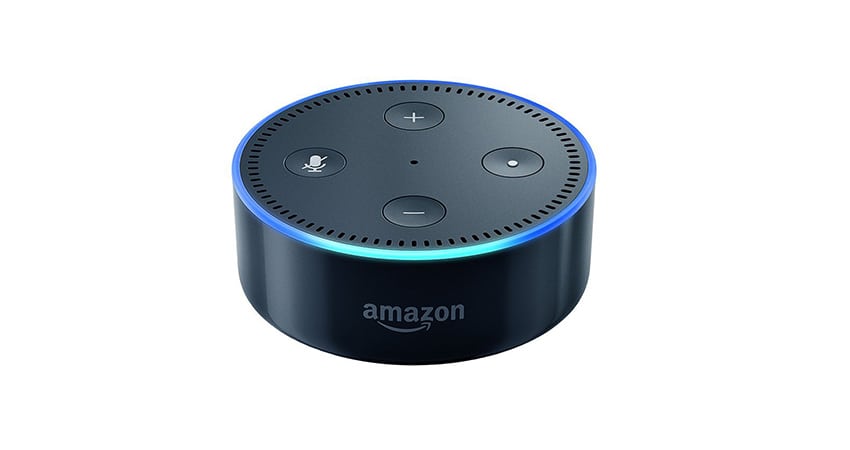Voice shopping just got a lot more realistic with the recent moves by Amazon, Google, and Walmart to drive voice-activated shopping into more and more homes. With Apple entering the fray with its new HomePod, the stage is set for a new round of retail disruption.
Having these major players in the race makes it only a matter of time before voice shopping becomes commonplace. This is good news for consumers, who will be able to order products and have them delivered to their homes without lifting a finger.
RBC Capital Markets projects that Amazon’s Alexa-driven Echo alone could become a “mega hit” and a $10 billion business by 2020. RBC estimates 128 million Echo devices will be installed in homes by 2020, with each customer spending $400 per year shopping.
With such a large market opportunity in sight, Amazon and Google have been waging a war to attract users and retailers to their voice shopping platforms. In the latest round, Walmart has teamed up with Google, joining Target and Costco in Google’s Home shopping stable.
U.S. consumers will have the ability to shop for products using the voice-activated Google Assistant platforms on phones and Google Home devices. Shoppers also will be able link their accounts to Google Express and quickly order by voice commands via Google Home.
Amazon, meanwhile, has forged an alliance with Kohl’s in which Amazon will open boutiques within Kohl’s stores staffed by Amazon associates who will sell Amazon smart-home devices and services. Customers will be able to schedule an in-home consultation as well as have access to Amazon Home Services – Amazon’s version of Angie’s List – through which they can connect to pre-screened local services professionals such as house cleaners and plumbers.
Amazon also launched a half-dozen new Echo products, including the Echo Button, Echo Connect and Echo Spot to its list.
Playing From Behind
Although the Walmart alliance strengthens Google’s hand, it still has a steep climb to catch Amazon. As the first mover, Amazon Echo has enjoyed a large lead over Google Home, with the latest figures showing Amazon owning 71% of the voice speaker market vs. Google’s 24%.
Amazon has been using Prime Day, its version of a Black Friday sale that takes place each year on July 11, to drive ever more numbers of its Echo units into homes. This year, Amazon offered $10 discounts and lowered the price of Echo devices by 50% on Prime day, which resulted in Echo devices selling at a rate of “thousands per minute,” seven times more than Prime Day 2016.
Amazon already had Walmart as a retail partner, and as a study by Bloomreach showed, 55% of product searches begin on Amazon, a fact that disadvantages Google. For Walmart, allying with Amazon and Google enables it to have the widest presence on home voice-shopping devices.
Major Market Opportunity
As increasing numbers of consumers install voice-shopping devices, it’s easy to see why retailers want to stay on top of the trend and position themselves for conversational commerce. In 2016, 80 million smart home devices were delivered worldwide. That’s a 64% increase from 2015.
The total number of U.S. homes with voice-activated assistant devices will reach
35.6 million this year, a 129% year-over- year increase, with Amazon owning 70% of
the U.S. market, according to eMarketer.
Amazon’s $13.7 billion acquisition of Whole Foods makes a lot of sense in this context, enabling Amazon to meet a wider spectrum of consumer’s shopping needs, including voice-ordering of groceries delivered to homes in one or two hours via Amazon Prime.
Whole Foods sells high-quality produce that consumers would be more likely to trust for home delivery without inspection. And as Forbes points out, Whole Food’s private brand creates a reason for the consumer to buy through Amazon as opposed to going elsewhere.
Easy-Peasy Shopping
For the consumer, what makes voice-shopping the natural next step in ecommerce is the easy and conversational nature of the buying process. Just imagine, all a consumer has to say is, “OK Alexa, order my groceries” and they will never have to step foot in a grocery store again.
While Amazon’s upscale Whole Foods customers may be more receptive to receiving the brand’s high-quality produce without inspection, there will always be consumers who are picky about their groceries and will want to examine their meat, fruit, and vegetables before buying.
However, for many routine and known items like diapers, dish detergent, paper towels, ice cream, and corn chips, there is no need to examine before buying. Adding live streaming video and trusted in-store associates to the mix could induce more consumers to purchase produce remotely without live inspection.
For many items that consumers already buy online, like clothing, electronics, and beauty products, using a voice shopping device is not a big leap. One downside is that voice shopping currently does not allow consumers to easily research products and compare pricing before buying. But even this obstacle can be overcome by more powerful AI technologies that can shop comparatively and guarantee the best deal.
Voice Shopping Comfort Level
Millennials and Gen Z have an affinity for conversational commerce through extensive use of instant messengers like WhatsApp, Facebook Messenger, and WeChat. Moreover, surveys show that all generations favor engaging with retailers via instant messaging.
Add to this the experience and comfort level of engaging with voice assistants like Siri and Alexa on smartphones, and voice-shopping becomes a natural extension of consumers’ habits.
While voice shopping makes the ordering process immediate, retailers’ ability to provide speedy delivery is still a challenge. Autonomous vehicles, drones, and robots may be the future of delivery, but delivery today is still dependent on humans and traditional modes of transportation. To shrink the “last mile” of retail delivery, retailers are establishing distribution hubs and delivery networks. Amazon Prime has shrunk the last mile by giving customers one-hour and two-hour delivery options in particular areas.
Just the Beginning
We are only on the cusp of the voice shopping revolution. Advances in voice recognition, AI, The Internet of Things (IoT), and live streaming technologies will continue to improve the retail-on-demand experience and drive it deeper into the home. Leading the way are companies like Audioburst and Agora.io, which are making it easier to embed high-quality voice and video services into devices. Natural language processing and AI are the key enablers of the voice shopping experience.
As these technologies mature, voice shopping will allow for deep personalization and product recommendations. Retailers will be able to gain a shopper’s purchase history, learn more about their habits, and offer personalized service.
As Forbes points out, Amazon’s big differentiator lies in the company mastery of using data to better understand its customer’s needs, predict shopping behavior, and generate longevity with its loyal customer base. The data Amazon accumulates through voice-shopping will play into this strength.
Retailer Readiness
Although voice shopping is still in its infancy, the stage is set for yet another disruption of the retail industry. With Amazon, Google, and Apple battling for position and smart home technologies maturing rapidly, expect retail-on-demand to become a commonplace reality in the not-too-distant future.
To capitalize on the voice shopping opportunity, retailers should begin putting strategies in place to add voice-shopping capabilities to their programs. Customers already are demanding a personalized and simplified shopping experience, which retailers are working to deliver online and in stores. With the right strategy in place, voice shopping will fit naturally within a retailer’s overall omnichannel approaches.
Bart Mroz is the co-founder and CEO of SUMO Heavy

